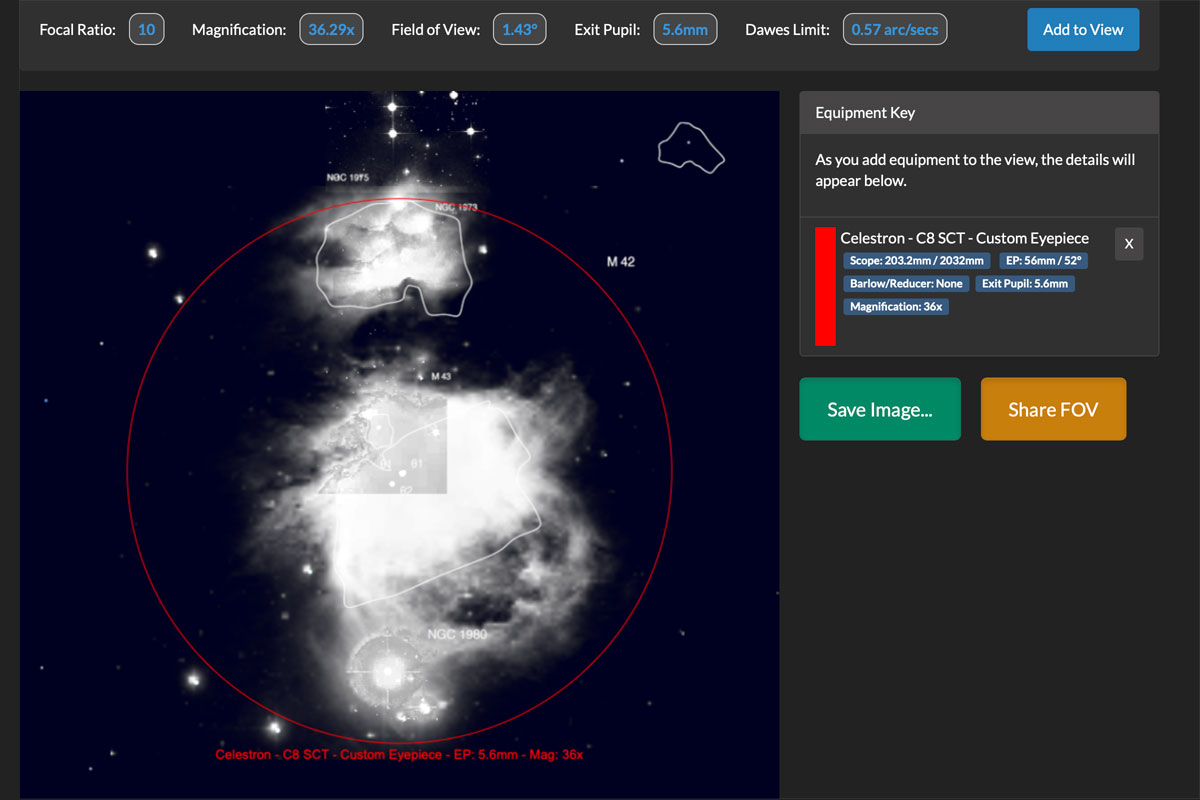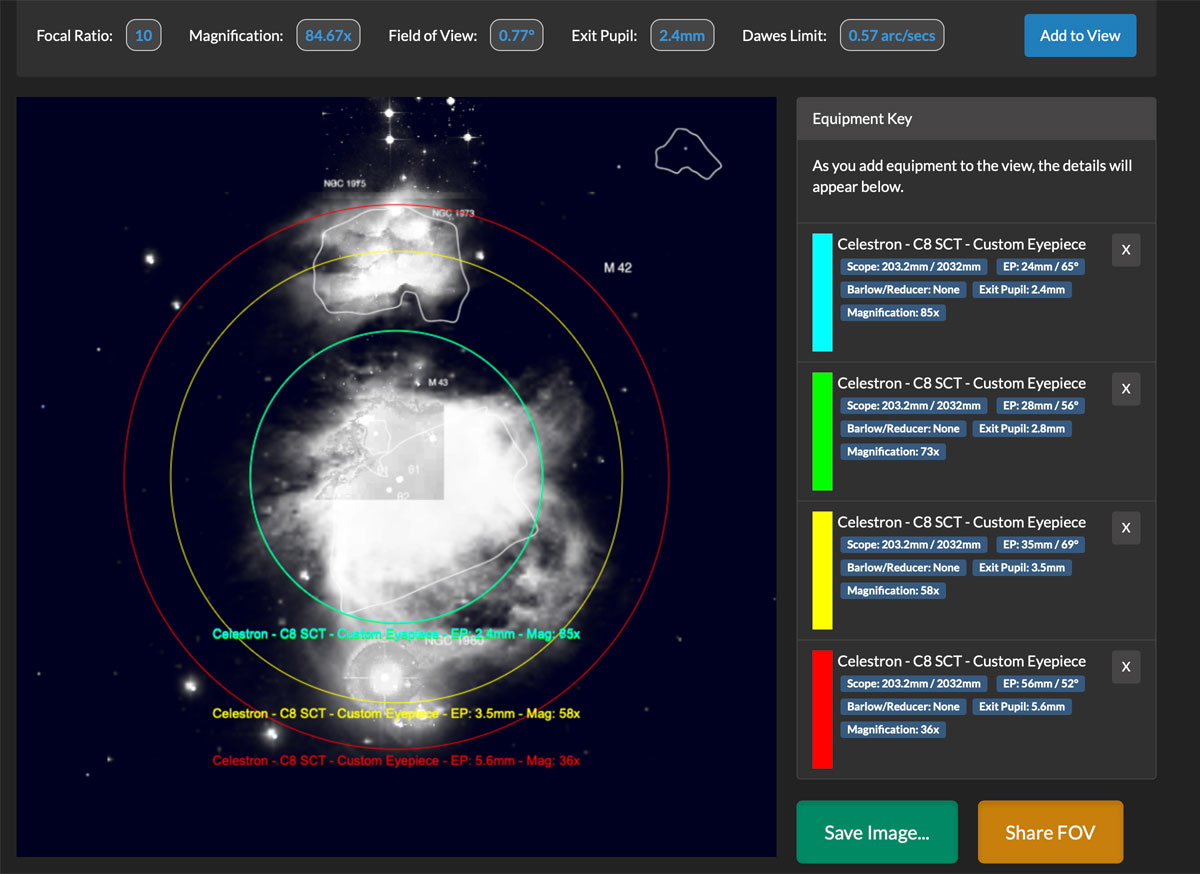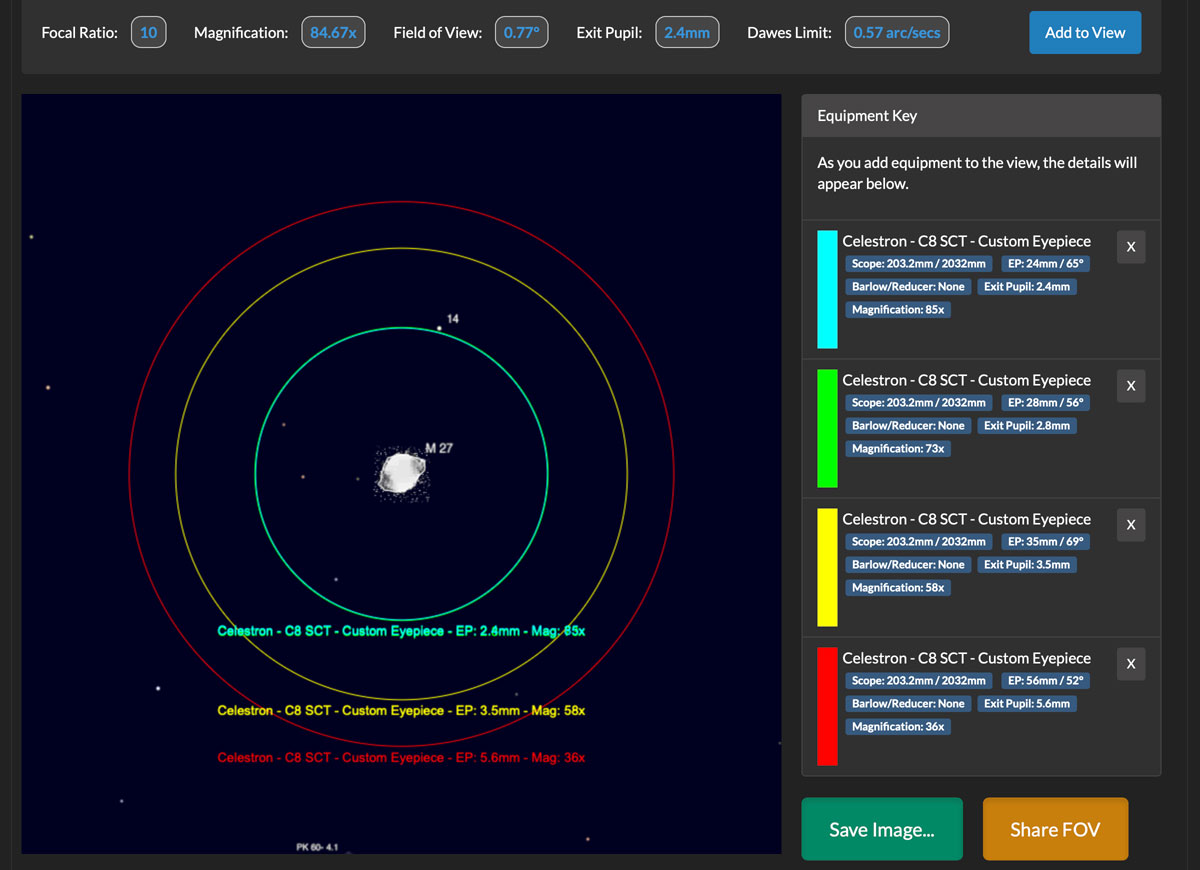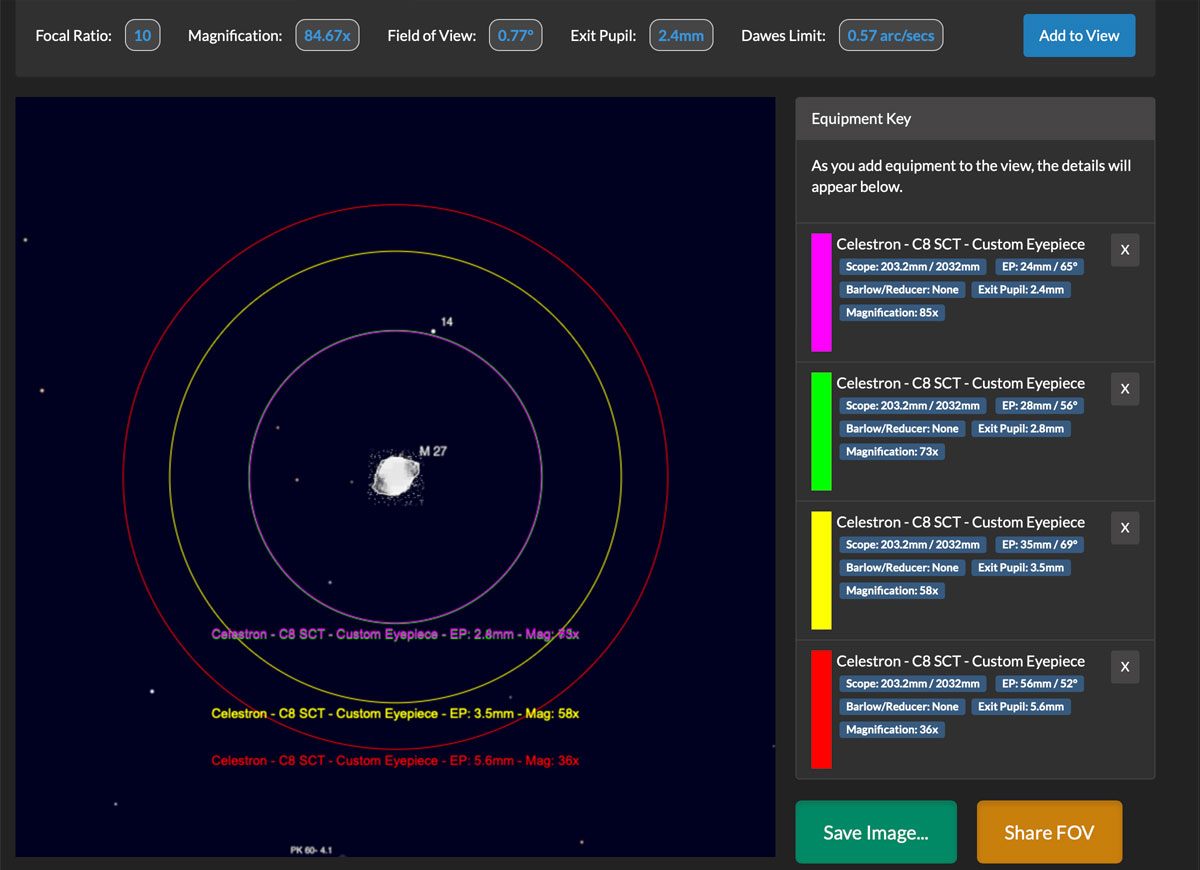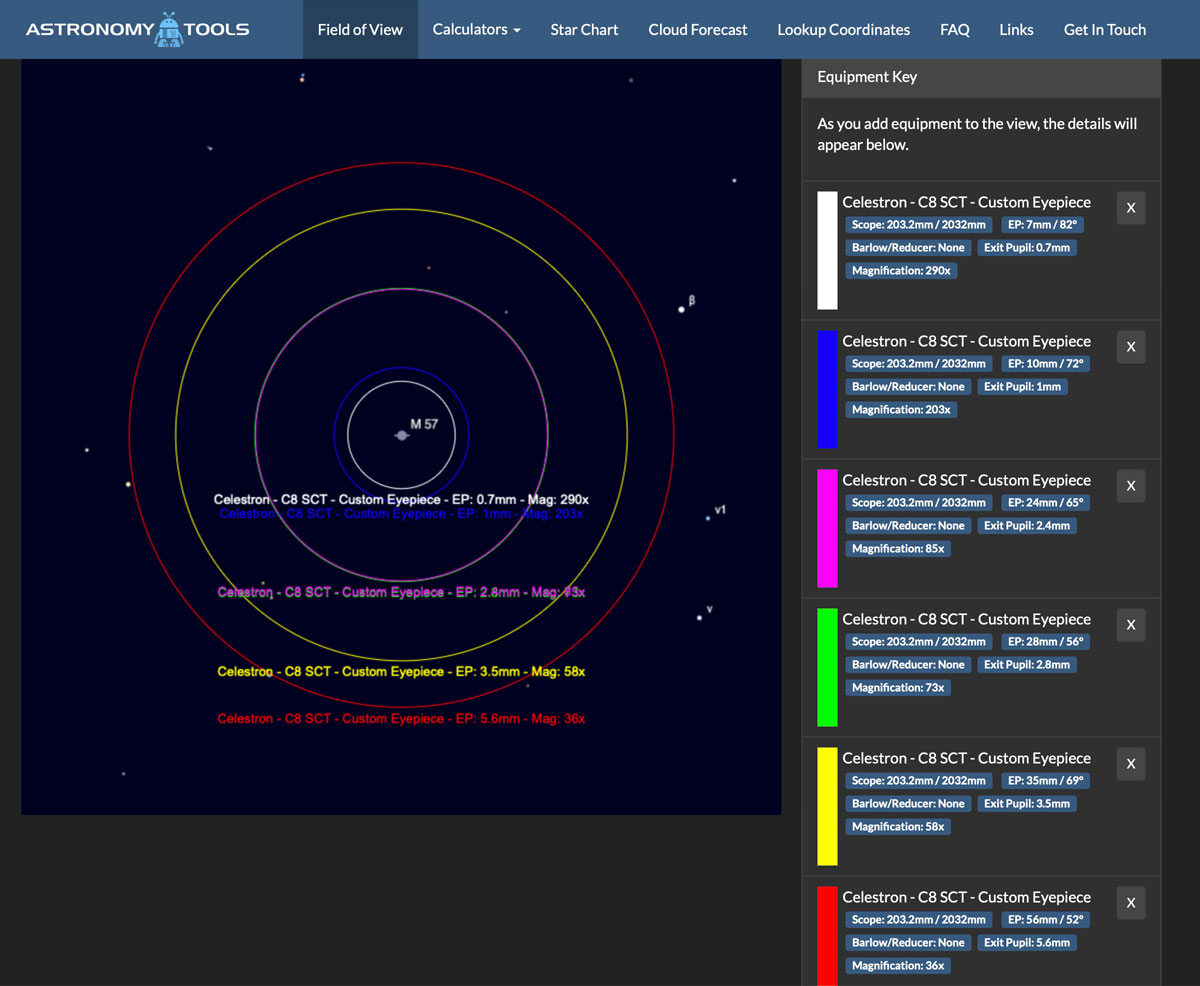Eyepiece Selection (Focal Length Selection) - Application Part 2
Introduction | Interactice Selection with Astronomy Tools | Resume | References
On this and further pages, I will deal with the selection of suitable eyepiece focal lengths for your own (or planned) telescopes as well as with the assessment of whether existing (or planned) eyepieces are suitable for these telescopes and fit together. Starting point are recommendations on the basis of the size of the exit pupil, which I found in the literature or on the Internet and which I have "consolidated" in my own recommendations.
Overview
-
On the first page, I present a more or less "theoretical" introduction to the topic, three variants of recommendations for selecting eyepiece focal lengths that are based on the size of the exit pupil, as well as an own "consolidated" one, which I derived from it. If you are not interested in the background of my recommendations, feel free to skip this page and proceed to the next one.
-
On the preceding page, I apply my "consolidated" recommendations to my own telescopes as an example. Readers should have no trouble applying the recommendations to their own (or prospective) telescopes. All you need to know is the focal ratio (for calculating the focal lengths of the eyepieces) and the aperture (for calculating the magnifications) of your telescopes!
I also take my existing eyepieces as an example and ask how they fit those recommendations. Readers should also be able to follow this step with their own (or prospective) eyepieces and telescopes. -
This page, the last one on this topic, deals with the question of how prospective eyepieces fit to the existing ones. In addition I choose an interactive approach, which was pointed out to me by a starfriend.
Once again, I would like to emphasize that I am still an astronomy beginner who has found these criteria in the literature or on the Internet, and now tries to apply them to his own equipment, hoping that this information is useful for other beginners in astronomy, too. I am far from giving recommendations for specific eyepieces, because I lack the respective experience. But be assured that the Internet is full of such recommendations ...
Note: For definitions in a small glossary, see page Quick & Dirty Astronomy Glossary.
Introduction
Current State (2019)...
On the previous page, I compiled my "own" recommendations (exit pupil as "criterion") based on my recommendations that I consolidated from sources on the Internet and books, which would make sense for my telescopes and which are listed in the table below (I also entered which focal lengths I already own):
| Criteria | Exit Pupil |
Focal
Length of Eyepiece |
|||||||||||||
C8 |
150PDS |
TLAPO1027 |
PS72 | 127 |
|||||||||||
| Category | Application Area | f > |
10 |
6.3 |
5 |
7 |
6 |
11.81 |
|||||||
| from | to | Rec | Is | Rec | Is | Rec | Is | Rec | Is | Rec | Is | Rec | Is | ||
| Maximum FOV | Search | 7 | 10 |
70-100 |
--- | 44-63 |
--- | 35-50 |
35, 38, 40 |
49-70 |
40 |
42-60 |
35, 38, 40, 56 |
83-118 |
32 |
| Minimum Magnification / Large FOV | Overview, large-area nebulae | 4.5 | 6.5 |
45-65 |
40, 56 | 28-41 |
32 | 22-33 |
24, 28,
32, 32 |
31-36 |
32, 35 |
27-39 |
28,
32, 32, 35, 38, 40 |
53-77 |
32 |
| Normal Magnification | Large-area, faint nebulae; nebulae, open star clusters | 3.5 | 4 |
35-40 |
35, 38, 40 | 22-25 |
24 | 17-20 |
16 |
24.5-28 |
24, 26, 28 |
21-24 |
24 |
41-47 |
32 |
| Best for many objects, e.g. for most galaxies, and mid-size DSO | 2 | 3 |
20-30 |
18, 24, 28, 32, 32 | 12.5-19 |
16 | 10-15 |
10, 16 |
14-21 |
16 |
12-18 |
10, 16, 18 |
24-36 |
24, 32 |
|
| Maximum Magnification / Maximum Resolution | "Normal" upper magnification limit; globular star clusters | 1 | 1.5 |
10-15 |
10-16 | 6.3-9.5 |
7, 10 | 5-7.5 |
7, * |
7-10.5 |
7, 10 |
6-9 |
7 |
12-18 |
10, 16 |
| Maximum perceptibility of small, low-contrast
details; planetary nebulae, small galaxies; maximum magnification for moon and planets |
0.6 | 0.8 |
6-8 |
7 | 3.5-5 |
4 | 3.0-4.0 |
4 |
4.2-5.6 |
4 |
3.5-5 |
4 |
7-9.5 |
7, 10 |
|
| Separation of narrow double stars, small planetary
nebulae; perception of faintest details |
0.4 | 0.5 |
4-5 |
4 | 2.5-3.2 |
* | 2.0-2.5 |
* |
2.8-3.5 |
*, 4 |
2.4-3.0 |
* |
4.7-6 |
4, 7 |
|
*) Possible with Explore Scientific focal extenders (2 x, 3 x, 5 x); bold: 2" eyepiece; italic: not possible; magenta: borrowed for evaluation (2"); gray: no longer in my possession
There are no real gaps in my eyepiece collection, consisting of 8 focal lengths and 3 additional focus extenders. At best, gaps might be spotted at short focal lengths, but these could be created by combining longer focal length eyepieces with focal length extenders. Only size and weight of these combinations might be disturbing. Nevertheless, again and again I feel the desire to buy additional eyepieces or to replace existing ones with new samples... For example, for the TLAPO1027, a 20 mm eyepiece might to be considered.
Looking back...
Since the current situation is not that helpful, I go back in time to a point in time when I only owned three UWA eyepieces (4, 7 and 16 mm), the 28 mm eyepiece for the Explorer 150PDS, and the 32 mm Plössl eyepiece for attaching a camera (no focus extender either...). Then the situation would look like this without the new TLAPO1027:
| Criteria | Exit Pupil |
Focal
Length of Eyepiece |
|||||||
150PDS |
PS72 |
127 |
|||||||
| Category | Application Area | f > |
5 |
6 |
11.81 |
||||
| from | to | Rec | Is | Rec | Is | Rec | Is | ||
| Maximum FOV | Search | 7 | 10 |
35-56 |
32 |
40-56 |
32 |
32-40** |
32 |
| Minimum Magnification / Large FOV | Overview, large-area nebulae | 4.5 | 6.5 |
24-32 |
28, 32 |
28-38 |
28, 32 |
32-40** |
32 |
| Normal Magnification | Large-area, faint nebulae; nebulae, star clusters | 3.5 | 4 |
16-20 |
16 |
20-24 |
16 |
32-40** |
32 |
| Best for many objects, e.g. for most galaxies, globular star clusters, and mid-size DSO | 2 | 3 |
10-15 |
16 |
12-18 |
16 |
24-32 |
32 |
|
| Maximum Magnification / Maximum Resolution | "Normal" upper magnification limit | 1 | 1.5 |
5-7.5 |
4, 7 |
6-9 |
7 |
12-18 |
16 |
| Maximum perceptibility of small, low-contrast
details; planetary nebulae, small galaxies; maximum magnification for moon and planets |
0.6 | 0.8 |
3.0-4.0 |
4 |
3.5-5 |
4 |
7-10 |
7 |
|
| Separation of narrow double stars, small planetary
nebulae; perception of faintest details |
0.4 | 0.5 |
2.0-2.5 |
-- |
2.5-3.0 |
-- |
5-6 |
4, 7 |
|
*) Possible with Explore Scientific focal extenders (2 x, 3 x, 5 x); bold: 2" eyepiece
Now the question arises where there are gaps in the range of eyepiece focal lengths and where additions to the eyepiece set would be appropriate. In principle, this is a "target/actual" comparison: the recommendations for the existing telescopes in the individual categories specify focal length ranges, and the "Is" column indicates whether the range can be served (or almost served) with the existing eyepieces. I will go through this in the following for my three telescopes.
150PDS
- "Search" is not well served, but perhaps that is not necessary either...
- The range of 10-15 mm (EP: 2-3 mm) is almost served by the 16 mm eyepiece; perhaps, a 10-12 mm eyepiece might be advisable...
- The exit pupil of "1 mm" is missed, but the 4 mm and 7 mm eyepieces come close (up to 1.5 mm EP).
- For an exit pupil of 0.4-0.5 mm there is no eyepiece (2-2.5 mm) available; whether a corresponding purchase would be worthwhile is questionable, because the magnification would already be well above 200 x and such an eyepiece can therefore only rarely be used.
PS 72/432
- "Search" is not well served, but perhaps that is not necessary either...
- The range of 20-24 mm (AP: 3,5-4 mm) is barely served by the 16 mm eyepiece; a 20-25 mm eyepiece might be advisable...
- The exit pupil of "1 mm" is missed, but the 7 mm eyepiece come close.
- For an exit pupil of 0.4-0.5 mm there is no eyepiece (2.5-3 mm) available; whether a corresponding purchase would be worthwhile is questionable, because the magnification would be beyond the beneficial magnification of the telescope.
SM-127
- For large exit pupils there are actually no eyepieces to buy.
- The exit pupil of "1 mm" is missed; a 10-12 mm eyepiece might be advisable...
- For an exit pupil of 0.4-0.5 mm there is no eyepiece (5-6 mm) available, but the 4 mm and 7 mm eyepieces come close.
What Might Be a Suitable Addition?
- If I want to do something for the search, I might consider buying an eyepiece between 32 mm and 56 mm (-> I bought a 2" eyepiece with a focal length of 35 mm).
- A 10-12 mm eyepiece would be advisable in two cases (-> I bought a 10 mm eyepiece - here I tried out different eyepiece types...).
- A 20-24 mm eyepiece would be advisable at least for the PS 72/432 (-> I already bought a 24 mm eyepiece before).
- A 2-3 mm eyepiece would be a possibility/addition in two cases (-> I purchased several focus extenders with which I can achieve these focal lengths).
All in all, I have - consciously or unconsciously - closed these gaps in the course of time, also by the acquisition of focal extenders. However, I always have to "force" me to utilize the focal extenders, because the resulting construction is quite "monstrous" (but the quality is generally quite good...).
What is not Considered in All This?
The selection of eyepiece focal lengths described on this page is based on the size of the exit pupil as a selection or application criterion. This criterion is based on the field of application of the eyepieces, but is by no means the only one that can be considered when selecting eyepieces and their focal lengths. In general, the selection of eyepieces and focal lengths is a very complex topic, which most hobby astronomers have to deal with during their entire hobby time. I do not want to go into these things any further here, but just list some criteria that are not considered when selecting eyepiece focal lengths on the basis of the exit pupil:
- Magnification (in connection with a certain telescope, calculated from the ratio of telescope and eyepiece focal length)
- Apparent field of view (angle of view; typically depending on the design) - can vary between 40 and 110 degrees (the magnification also determines the true field of view, i.e. the field of view shown by the eyepiece on a particular telescope)
- Viewing behavior with and without eyeglasses (eye relief and "steadiness" of the view)
- Sharpness distribution (e.g. very sharp in the center, rather blurred in the periphery versus evenly sharp)
- Transmission behavior (light transmission; often given by the number of lenses in the eyepiece, but not always...)
- Size and weight
- ...
The magnification, like the exit pupil, leads directly to an eyepiece focal length, the other criteria are more suitable for the comparison of eyepieces with similar or the same focal length - or also serve as a "unique selling point."
Apparent Field of View
Different types of eyepieces have a different apparent field of view, for example between 40 and 110 degrees. Therefore, it is possible to achieve the same field of view with eyepieces that have different focal lengths and apparent fields of view. If you use an online tool like the astronomy.tools eyepiece calculator (see below), it seems that these variants are equivalent. But they are only in relation to the field of view, because they enlarge differently and therefore have a different exit pupil (which results from the magnification or focal length of the eyepiece of a certain telescope). I would like to illustrate this with an example for the PS 72/432:
- 24 mm eyepiece with 65 degree apparent viewing angle: 3.61 degree viewing angle, exit pupil = 4.00, magnification = 18.00
- 28 mm eyepiece with 56 degree apparent viewing angle: 3.63 degree viewing angle, exit pupil = 4.67, magnification = 15.43
Thus, the image in the 28 mm eyepiece is smaller and brighter than in the 24 mm eyepiece with approximately the same sky section. The extent to which such differences in brightness are significant and the differences in size influence the recognition of fine structures is an empirical question and cannot be decided on the basis of pure numbers. Personally, I prefer eyepieces with a little more magnification and angle of view at the expense of the size of the exit pupil, because it allows me to see details better. Other starfriends may have different preferences....
Approaching the Seeing Limit at Short Focal Lengths
A starfriend has pointed out to me that at higher magnifications, it can be useful to have a series of finely graduated eyepieces to find the optimal eyepiece for a borderline situation (maximum magnification with optimal details). In this range, he even owns a collection of eyepieces with 1 mm gradation...
Other...
Of course, there are other characteristics of eyepieces, such as the viewing behavior, the eye relief and others, which are not considered in these considerations. It is not for nothing that many amateur astronomers are constantly busy "optimizing" their eyepiece park.
Interactive Selection with Astronomy Tools
While I prefer numbers, other star friends prefer interactive tools. The FOV calculator from astronomy.tools is a good choice for guiding the eyepiece selection. A star friend told me that he used the tool for this purpose. I myself have used it for other purposes, namely for the calculation of sky sections that cameras show.
You can specify a sky object (typically a Messier object) that you want to observe or photograph, for example, by entering your telescope's data, entering the eyepiece data (including focal length extenders or reducers), and then getting a graph that shows what section of the sky you see around the specified sky object. The program calculates different data for one eyepiece (and telescope), and if you have specified several eyepieces, it also displays them for several eyepieces. This way, the graph can show how these eyepieces fit together.
Figure: Field of View Calculator by Astronomy Tools, telescope C8, default eyepiece, and M 42 specified (the results are displayed below this - see the next figure)
Figure: Graph created by the Field of View Calculator of Astronomy Tools for the C8 telescope C8 demonstrating how a 56 mm eyepiece shows M 42
Figure: Graph created by the Field of View Calculator of Astronomy Tools for the C8 telescope C8 demonstrating how four different eyepieces show M 42, two of them having an identical field of view
In the graph, the viewing angle only appears as a circle, but no longer as a numerical value, although there would still de room for this. If you specify eyepieces with a similar viewing angle, the texts in the graphic overlap, as demonstrated in the Figure above, and you only see the last one specified. In my opinion, there is still room for improvement...
Figure: Graph created by the Field of View Calculator of Astronomy Tools for the C8 telescope C8 demonstrating how these four eyepieces show M 27, two of them having an identical field of view
Figure: Here, the last added eyepiece was deleted and added again; afterwards its ring appeared in a different color, so that it is better to see that there are two eyepieces with identical field of view
Figure: Here, the sky object was changed to M 57 and a 10 mm eyepiece (a magnification of about 200 x) and a 7 mm eyepiece (a magnification of about 290 x) added
Notes
Everyone will decide for him- or herself whether he or she prefers numbers or graphics. In any case, with this tool you will quickly reach your goal. However, I had to enter my data again and again, because the tool did not remember it. Also I was not able to add new eyepieces to save work this way...
I would like to note that circle of the same size means that the sections of the sky are identical, but the "visual impression" can be different because the magnification of the eyepieces can be different and consequently the exit pupil (and the apparent angle of view given by the eyepiece type). In my eyes, this fact is not made sufficiently clear in the FOV Calculator.
Resume
On this page I present once again the results of my focal length recommendations for eyepieces based on the exit pupil. Then I apply this approach to a state of my equipment in the past to see how useful it is. Finally, I discuss an alternative graphical approach that uses the FOV Calculator by Astronomy Tools and which a starfriend pointed me to. So, here I have discussed a "number based" and a graphical approach. Which approach you choose for selecting eyepieces is definitely a matter of your personal preferences...
References
- Ronald Stoyan (2015, 5. verbesserte Auflage). Deep Sky Reiseführer, Oculum-Verlag: Erlangen (in German).
- Forumsbeitrag (penumbra): Mein neues Teleskop (indiana-jones-forum.de/print.php?id=7505&page=1) (in German)
- Eyepiece (Wikipedia): en.wikipedia.org/wiki/Eyepiece
- Okularberatung (Eyepiece consultation; Intercon Spacetec): www.intercon-spacetec.de/beratung/okulare/okularberatung (in German)
- Okularberatung (Eyepiece consultation; Televue-Website by Intercon Spacetec): www.televue.de/beratung-okular (in German; older, but more or less identical version)
- Astronomy Tools: astronomy.tools - FOV calculator: astronomy.tools/calculators/field_of_view
| 21.11.2024 |

